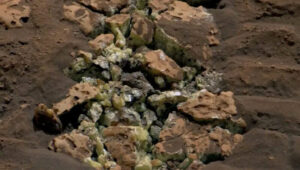Platinum and gold are common, if expensive, in watches, necklaces, and rings. There’s also platinum in our electronic devices, rhodium in catalytic converters, and palladium in dental crowns. Most of us don’t realize how incredible it is that these rare metals are here at all, let alone in such quantities.
The density of precious metals in the Earth’s mantle is much higher than it should be, but why? Researchers have long believed that they came aboard giant space rocks that collided with our planet just after it formed. But over time, they should have sunk into the Earth’s core. How did metals like gold and platinum end up so near the surface?

The simulation above shows the mixing of the metal from the asteroid or protoplanet over time. The top panel illustrates right after impact, when the metal (green/yellow) is all in one layer. Over time, bottom two panels, the metals have sunk into pockets in the mantle. Image: Korenaga and Marchi 2023
Gold, platinum, palladium, rhodium, iridium, osmium, rhenium, and ruthenium, those elements that came to Earth through impacts from giant asteroids and protoplanets, all bind easily to iron. But instead of sinking to our planet’s iron-rich core, they remained relatively near the surface, in the mantle. A very lucky, but also confusing phenomenon.
Two scientists, Jun Korenaga and Simone Marchi, carried out simulations to try and replicate what happened after these ancient collisions. They think they have solved the mystery.
As the huge space rocks smashed into our young planet, the huge impact created an ocean of molten magma in the crust and upper mantle. This ocean trapped the metals. The metals initially started sinking, then hit a partly molten transition layer.
At this point, the sinking slowed and allowed the lower mantle time to solidify completely before the precious metals reached it. Rather than continuing down to the core, they became trapped in the mantle. Over billions of years, thermal currents from the Earth’s core have moved the valuable metals closer to the surface.

Cross section of the Earth’s layers. Elements of this image furnished by NASA. Photo: Shutterstock
The delivery of precious metals into those realms within our reach is still ongoing, according to the new study. Two sections of the deep mantle, one below Africa and the other below the Pacific Ocean, remain rich in precious metals. They are the leftovers of the transient zone. During earthquakes, the shock waves move more slowly through these sections of the mantle, showing their position.
Next, the researchers want to reenact their simulation, to see if early Mars and Venus followed the same pattern.






